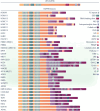NUP98 oncofusions in myeloid malignancies: An update on molecular mechanisms and therapeutic opportunities
- PMID: 39323480
- PMCID: PMC11423334
- DOI: 10.1002/hem3.70013
NUP98 oncofusions in myeloid malignancies: An update on molecular mechanisms and therapeutic opportunities
Abstract
Acute myeloid leukemia (AML) is an aggressive hematological malignancy with a heterogeneous molecular landscape. In the pediatric context, the NUP98 gene is a frequent target of chromosomal rearrangements that are linked to poor prognosis and unfavorable treatment outcomes in different AML subtypes. The translocations fuse NUP98 to a diverse array of partner genes, resulting in fusion proteins with novel functions. NUP98 fusion oncoproteins induce aberrant biomolecular condensation, abnormal gene expression programs, and re-wired protein interactions which ultimately cause alterations in the cell cycle and changes in cellular structures, all of which contribute to leukemia development. The extent of these effects is steered by the functional domains of the fusion partners and the influence of concomitant somatic mutations. In this review, we discuss the complex characteristics of NUP98 fusion proteins and potential novel therapeutic approaches for NUP98 fusion-driven AML.
© 2024 The Author(s). HemaSphere published by John Wiley & Sons Ltd on behalf of European Hematology Association.
Conflict of interest statement
Olaf Heidenreich received research funding from Syndax and Roche. The other authors declare no conflicts of interest.
Figures




References
-
- Hoffman AE, Schoonmade LJ, Kaspers GJ. Pediatric relapsed acute myeloid leukemia: a systematic review. Expert Rev Anticancer Ther. 2021;21(1):45‐52. - PubMed
-
- Klein K, de Haas V, Kaspers GJL. Clinical challenges in de novo pediatric acute myeloid leukemia. Expert Rev Anticancer Ther. 2018;18(3):277‐293. - PubMed
Publication types
LinkOut - more resources
Full Text Sources
